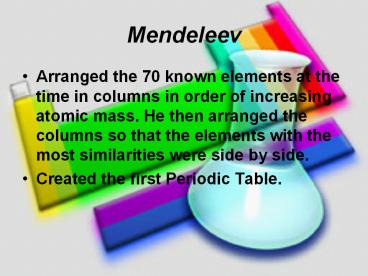Mendeleev - PowerPoint PPT Presentation
1 / 23
Title:
Mendeleev
Description:
Mendeleev Arranged the 70 known elements at the time in columns in order of increasing atomic mass. He then arranged the columns so that the elements with the most ... – PowerPoint PPT presentation
Number of Views:107
Avg rating:3.0/5.0
Title: Mendeleev
1
Mendeleev
- Arranged the 70 known elements at the time in
columns in order of increasing atomic mass. He
then arranged the columns so that the elements
with the most similarities were side by side. - Created the first Periodic Table.
2
Mendeleevs First Periodic Table
3
Periodic Table an arrangement of the elements
according to the similarities in their properties
- Mendeleev was even able to predict the physical
and chemical properties of the missing elements.
(When these elements were discovered, they were
found to have properties similar to those
predicted)
4
Moseley
- Moseley later arranged the elements in a table by
order of atomic number instead of atomic mass
5
The Periodic Table
- Periods
- horizontal rows are called periods
- There are seven periods
- The properties within a period change as you move
across it from element to element - If you move from one period to the next, the
properties within the period repeat - All elements in a period have the same of
atomic orbitals - Ex. First period (1 orbital)
- Second period (2 orbitals)
6
The Periodic Table
- Groups or Families
- Vertical columns of elements in the PT
- The elements in any family of the PT have similar
physical and chemical properties - Have the same number of electrons in their outer
orbitals (valence electrons) - Hydrogen has characteristics of both group 1 and
7 - Helium needs only two electrons in its outer
shell to be filled (happy). - Families have specific names associated with them
because they have similar physical and chemical
properties
7
(No Transcript)
8
75 of Elements are Classified as Metals
- Properties of metals
- conduct electricity
- high luster
- ductile (able to be drawn into wires)
- malleable (able to be beaten into thin sheets
- elements on the left and center of the PT are
metals
9
Groups or Families divided into 8 groups
10
(No Transcript)
11
Group 1 Alkali Metals
Li
- very reactive
- never found free in nature
- react readily with water
- shiny, light in weight
Na
K
Rb
Fr no images of Francium available
Cs
12
Group 2 Alkaline Earth Metals
- reacts with oxygen
- not as reactive as Group 1, makes bonds very
easily
Ca Calcium
13
- Group 3
- Boron group, made of metals and metalloids
- Group 4
- Carbon group, made of Metals and Nonmetals
- Group 5
- Nitrogen group, elements form an oxygen or sulfur
compound - Group 6
- Oxygen group, Nonmetals
14
Group 7 Halogens
- elements combine violently with alkali metals to
form salts - Halogens mean salt-forming
- Highly reactive
- 7 electrons in outer shell, only need one to be
happy
15
Group 8 Noble Gases
- have full outer shells with 8 electrons (except
for He) - least reactive group
- not very abundant
- Neon in advertisement signs
- Argon light bulbs
- Helium balloons
- Xenon used in headlamps (ultra bright-blue)
16
Metalloids
- Stair step line that distinguishes metals from
non-metals. Drawn from between Boron Aluminum
to the border of Polonium Astatine - Boron
- Silicon
- Germanium
- Arsenic
- Antimony
- Tellurium
- Polonium
17
Transition Metals
- All elements between Group 2 and Group 3,
including the inner transition metals (lanthanide
actinide series) - Able to put more than 8 electrons in their next
to last shell - Can use the two outermost orbitals to bond with
other elements - Actinide series are radioactive and some cannot
be found in nature - Lanthanide series can be found naturally on earth
18
Transition Metals
19
Periodic Table Review
- What criteria did Mendeleev use to construct his
PT? - arranged elements by order of atomic number
- arranged elements by order of atomic mass
- What criteria did Moseley use to reconstruct the
PT? - arranged elements by order of atomic number
- arranged elements by order of atomic mass
20
Review
- A period on the Periodic Table
- is represented by vertical columns of elements
which have similar physical properties and
chemical properties - is represented by horizontal rows of elements and
the properties of the elements change as you move
from element to element
21
Review
- A Family/Group on the Periodic Table
- is represented by vertical columns of elements
which have similar physical properties and
chemical properties - is represented by horizontal rows of elements and
the properties of the - elements change as you move from element to
element
22
Review
- Identify each element as a metal, metalloid, or
nonmetal - gold
- silicon
- manganese
- sulfur
- barium
- Metal
- Metalloid
- Metal
- Nonmetal
- Metal
23
Review
- Pick two elements that have properties similar to
those of the element calcium - Zn
- Mg
- Cr
- Sr































